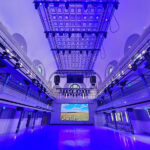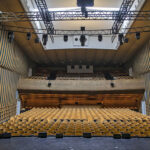An American Movie Palace Gets a Lighting Makeover
The Michigan Theater in Ann Arbor is one America’s original movie palaces. Built in 1928 during the silent movie era, the theatre also hosted vaudeville stage shows — it is still home to a 1927 Barton Theater Pipe Organ — before giving way to talkies and live musical performances.
But while the entertainment has changed with the times, the technology in the theatre hasn’t always kept up — until now.
In 1983, the original lighting system — a resistance dimmer board manufactured by Major — was replaced with 54 Leprecon LD 2400-watt dimmers, and five electrics were added over the stage. For the next 25 years, this was the extent of the Michigan Theater’s lighting system.
“We have 172 circuits that could patch into those 54 dimmers via a patch panel which was manufactured by Ruhl,” says Scott Clarke, who has been working at the Michigan Theater since 1981, when he took a job as a relief projectionist. Nearly 28 years later, he’s been the house technician and facility director, and now serves as the technical director.
“We installed that system in 1983, and that was about the time that patch panels became obsolete,” he says, noting that the trend at the time was toward dimmer-per-circuit. Five years af-ter the system was installed, Clarke could no longer get parts for his patch panel.
The panel’s high voltage interconnect system, with circuits mechanically patched into a dimmer, was highly susceptible to dust and humidity. And given that the Michigan Theater didn’t have a modern air conditioning system, there was a lot of humidity.
“We had a lot of problems where the connections on the patch panel would arc and eventually weld themselves in place,” Clarke says. “I started using the few replacement parts I had, and then started stealing parts from circuits I didn’t need as much, because I needed the parts to keep the rest of the system running.”
Border lights and other circuits were eliminated as Clarke borrowed parts to repair the patch panel.
“Eventually, there weren’t any more parts to steal,” Clarke says. “We were at the point where we were going to need to start eliminating the important stuff.”
Complete Production Systems became involved with the Michigan Theater through Brass Ring Productions and Prism Productions, promoters of live musical events hosted in the theatre. Noting that the Michigan is the only venue in Ann Arbor not owned by the University of Michigan, CPS president Bill Pierson calls the Michigan “a breath of fresh air.”
“My company has tried over the years to do all that was possible to try to help the Michigan with donations of used equipment, special pricing on new equipment and generally being supportive wherever we could,” Pierson says.
CPS had upgraded the theater’s dimmers about eight years ago to accept DMX. Pierson says the LD-2400 dimmers had been solid workhorses, working day after day in the theatre, but they weren’t part of a feasible long-term plan.
For the installation of the new system, Pierson says a big challenge was to fit modern dimming system racks into onstage space that had originally held the old resistance dimmer board. This meant the racks needed to be assembled at Leprecon, then disassembled and transported to the Michigan for installation.
“The plan was to re-use as much as possible and to allow the theatre to use all of the existing circuits on a dimmer-per-circuit basis,” he says. “This would negate the need to re-patch for access to dimmer channels and save a busy theatre time on every load-in.”
With CPS’ help, the Michigan’s system went from 54 to 192 channels of 2.4kW dimmers, during an install window of just two weeks when the theatre had no live performances scheduled.
During the installation, the Michigan was still showing movies every night, presenting Clarke with an unexpected technical challenge as he dismantled the old patch panel.
“I discovered that all of the house lighting wiring ran through this panel in such a way that I had to disconnect it all and then reconnect it on a temporary basis while I did the install, and then reroute everything back through. So that was a bit of a surprise,” he laughs, remembering that it took a few days just to identify everything for rerouting.
The installation of the new system, however, was a breeze. Clarke replaced the stage dimmers with 192 new VX Leprecon dimmers, which he describes as “just wonderful.”
“I have a dimmer-per-circuit plus a few to spare for when I expand my front of house positions some day,” he says.
“We tore the old stuff out and got the new stuff in,” Clarke says. “It went in beautifully. It was like it was meant to be there.”
Clarke is pleased with his Leprecon L1600 control system, which has capacity for 12 pages of 36 presets each.
“I think we’ve only ever gone to page two for a show,” Clarke laughs. He says live performances at the Michigan are strictly one-day rock music shows, symphony concerts or children’s thea-tre shows. The Michigan also shows first-run, independent movies.
“In terms of the console, it’s not very fancy,” he says. “I don’t have moving lights or anything like that. But for what I do, it’s perfect.”
Clarke chose Leprecon over ETC for two simple reasons. One, Leprecon dimmers are manufactured right down the road in Hamburg. Secondly, Leprecon donated a new control board to the not-for-profit theatre.
“They’re currently designing a new upgrade to the board that I use,” says Clarke. “They’re going to give me one to beta test. And when we get it all tested and they’re ready to go with the product, they’re going to give me a brand new one to live with. They kind of sweetened the deal.”
Pierson praises Leprecon’s reliability, ease of service and the amazing track record of the Michigan’s previous Leprecon dimming system. “The Leprecon 2400s that had been in-stalled in 1983 had served the busy venue for 25 years with very little maintenance,” he says.
While the first phase of the project focused on replacing the patch panel, a future phase will upgrade the house lighting system, currently an obsolete Electro Controls system with ETC Source Four Ellipsoidals, Source Four PARs, some old PAR 64s over the stage, and Altman 6x22s and 6x16s front of house.
The decorative lighting, cove lighting and grill lighting is all 100-watt incandescent lamps using up 24 dimmers. Clarke looks forward to getting the house lighting system down to just 12 dimmers for chandeliers and other fixtures.
“Certainly for all that decorative stuff it would be silly to buy a whole new system of 36 dimmers to continue using incandescent bulbs in all of these house lighting fixtures,” he says.
Clarke says he’s looking into installing new LED fixtures, which will be more cost-effective and create an energy savings in the long-term.
“The neat thing about this place is it’s 100 percent supported by the community, and we can’t do anything unless the community really wants us to do it,” Clarke says. “They’ve been really generous in wanting us to continue to do what we do.”
The Michigan Theater is owned and run by The Michigan Theater Foundation, after the citizens of Ann Arbor purchased the historic theatre from W.S. Butterfield Theaters, Inc. in 1979 and later deeded it to the foundation.
Clarke says the Michigan has raised over $10 million to restore the theatre to its original grandeur and to improve the facility through the addition of a second screening room and other new spaces.
When it became obvious that the theatre’s lighting system would need to be replaced, the foundation started the “Light it Up” campaign.
“They raised money just for this project, to replace this patch panel and the old dimmers with a dimmer-per-circuit,” Clarke says. He estimates the campaign raised about $80,000, with the theatre kicking in the rest of the money for the budgeted $100,000 project.
Clarke spent about $60,000 on the first phase of the project. The house lighting phase has been delayed by roof leaks, but he’s looking forward to getting the rest of the job done. “When we get around to doing the house lights, I’ll still have some money to spend, which is nice,” he says.
While the Michigan Theater’s new lighting system may not be able to compete with technology in some of the other nearby venues with their bells and whistles — like the Lydia Mendelssohn Theater and the Power Center for the Performing Arts, both owned by the University of Michigan — the upgrade will provide more options for shows that come to the Michigan.
“Because I have a dimmer-per-circuit here, when you’re designing a show, you don’t have to gang these things as far as they can go,” Clarke says. “It enhances the ability of the de-signers to be more creative.”
He says the Michigan is now more competitive with a new system that is easy for traveling shows to tie into, but admits that the University of Michigan venues have more advanced equipment — with new ETC dimming systems and LED fixtures.
“We can’t really compete in terms of inventory,” he says. “But we have heart.”
Ultimately, Clarke doesn’t think Michigan Theater audiences will notice the new lighting system.
“If we do our job right, it still looks like magic to them,” he says.
“The Michigan is a wonderful and unique facility in the classic movie palace style,” says Pierson, who believes the addition of modern technology will serve to make the theatre more usable and help ensure its continued existence. “The Michigan Theater is like a beautiful lady that seems to grow ever more beautiful with age.”







